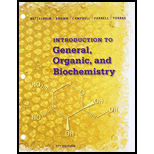
Concept explainers
6-35 Describe how we would prepare the following solutions:
(a) 280. mL of a 27% v/v solution of ethanol C2H6O, in water
(b) 435 mL of a 1.8% v/v solution of ethyl acetate, C4H8O2 in water
(c) 1.65 L of an 8.00% v/v solution of benzene C6H6, in chloroform, CHCI3
(a)
Interpretation:
The formation of following solutions should be explained:
280.0 mL of a 27% v/v solution of ethanol,
Concept Introduction:
Concentration has several ways to be calculated. It typically relates an amount of solute and the solution. In volume of solute per unit volume of solvent, or v/v, the total volume of the solute, solvent and solution must be known.
The formula for v/v is as follows:
Here,
When solving for the required volume of solute, the following formula is used:
Answer to Problem 6.35P
Explanation of Solution
Given:
The formula for v/v is as follows:
Here,
When solving for the required volume of solute, the following formula is used:
Substitute known data and solve for mass of solute.
Thus, add
(b)
Interpretation:
The formation of following solutions should be explained:
435 mL of a 1.8 % v/v solution of ethyl acetate
Concept Introduction:
Concentration has several ways to be calculated. It typically relates an amount of solute and the solution. In volume of solute per unit volume of solvent, or v/v, the total volume of the solute, solvent and solution must be known.
The formula for v/v is as follows:
Here,
When solving for the required volume of solute, the following formula is used:
Answer to Problem 6.35P
Explanation of Solution
Given:
The formula for v/v is as follows:
Here,
When solving for the required volume of solute, the following formula is used:
Substitute known data and solve for mass of solute.
Then, add
(b)
Interpretation:
The formation of following solutions should be explained:
1.65 L of a 8.00 % v/v solution of benzene,
Concept Introduction:
Concentration has several ways to be calculated. It typically relates an amount of solute and the solution. In volume of solute per unit volume of solvent, or v/v, the total volume of the solute, solvent and solution must be known.
The formula for v/v is as follows:
Here,
When solving for the required volume of solute, the following formula is used:
Answer to Problem 6.35P
Explanation of Solution
Given:
The formula for v/v is as follows:
Here,
When solving for the required volume of solute, the following formula is used:
Substitute known data and solve for mass of solute.
Then, add
Want to see more full solutions like this?
Chapter 6 Solutions
Bundle: Introduction to General, Organic and Biochemistry, 11th + OWLv2, 4 terms (24 months) Printed Access Card
- 6-54 An industrial wastewater contains 3.60 ppb cadmium Cd2+. How many mg of Cd2+ could be recovered from a ton (1016 kg) of this wastewater?arrow_forward6-38 Describe how we would prepare 250 mL of 0.10 M NaOH from solid NaOH and water.arrow_forward6-40 What is the molarity of each solution? (a) 47 g of KCI dissolved in enough water to give 375 mL of solution (b) 82.6 g of sucrose, C12H22O11, dissolved in enough water to give 725 mL of solution (c) 9.3 g of ammonium sulfate, (NH4)2SO4 dissolved in enough water to give 2.35 L of solutionarrow_forward
- 6-16 Answer true or false. (a) Solubility is a physical property like melting point and boiling point. (b) All solutions are transparent—that is, you can see through them. (c) Most solutions can be separated into their components by physical methods such as distillation and chromatography.arrow_forward6-67 Calculate the freezing points of solutions made by dissolving 1.00 mole of each of the following ionic solutes in 1000. g of H2O. (a) NaCI (b) MgCI2 (c) (NH4)2CO3 (d) AI(HCO3)3arrow_forward6-37 Calculate the w/v percentage of each of these solutes: (a) 623 mg of casein in 15.0 mL of milk (b) 74 mg of vitamin C in 250 mL of orange juice (c) 3.25 g of sucrose in 186 mL of coffeearrow_forward
- 6-53 Dioxin is considered to be poisonous in concentrations above 2 ppb. If a lake containing L has been contaminated by 0.1 g of dioxin, did the concentration reach a dangerous level?arrow_forward6-43 The label on a sparkling cider says it contains 22.0 g glucose (C6H12O6) 190. mg K+ , and 4.00 mg Na+ per serving of 240. mL of cider. Calculate the molarities of these ingredients in the sparkling cider.arrow_forward6-48 How many grams of solute are present in each of the following aqueous solutions? (a) 575 mL of a 2.00 M solution of nitric acid, HNO3 (b) 1.65 L of a 0.286 M solution of alanine, C3H7NO2 (c) 320 mL of a 0.0081 M solution of calcium sulfate, CaSO4arrow_forward
- 6-15 Answer true or false. (a) A solute is the substance dissolved in a solvent to form a solution. (b) A solvent is the medium in which a solute is dissolved to form a solution. (c) Some solutions can be separated into their components by filtration. (d) Acid rain is a solution.arrow_forward6-112 List the following aqueous solutions in order of increasing boiling point: 0.060 M glucose (C6H12O6), 0.025 M LiBr, and 0.025 M Zn(NO3)2.Assume complete dissociation of any salts.arrow_forward6-99 A concentrated nitric acid solution contains 35% HNO3. How would we prepare 300. mL of 4.5% solution?arrow_forward
 Introduction to General, Organic and BiochemistryChemistryISBN:9781285869759Author:Frederick A. Bettelheim, William H. Brown, Mary K. Campbell, Shawn O. Farrell, Omar TorresPublisher:Cengage Learning
Introduction to General, Organic and BiochemistryChemistryISBN:9781285869759Author:Frederick A. Bettelheim, William H. Brown, Mary K. Campbell, Shawn O. Farrell, Omar TorresPublisher:Cengage Learning General, Organic, and Biological ChemistryChemistryISBN:9781285853918Author:H. Stephen StokerPublisher:Cengage Learning
General, Organic, and Biological ChemistryChemistryISBN:9781285853918Author:H. Stephen StokerPublisher:Cengage Learning

